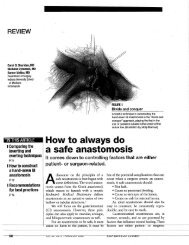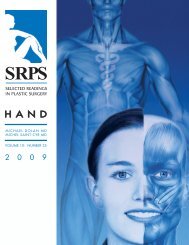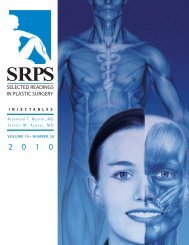Craniofacial Anomalies, Part 2 - Plastic Surgery Internal
Craniofacial Anomalies, Part 2 - Plastic Surgery Internal
Craniofacial Anomalies, Part 2 - Plastic Surgery Internal
You also want an ePaper? Increase the reach of your titles
YUMPU automatically turns print PDFs into web optimized ePapers that Google loves.
Associated <strong>Anomalies</strong><br />
Although cervical spine anomalies are not usually<br />
mentioned in association with craniosynostosis,<br />
intervertebral fusion has been documented in 71%<br />
of children with Apert syndrome, in 38% of those<br />
with Crouzon disease, and in 30% of those with<br />
Pfeiffer syndrome. 300 Fusions are most often isolated<br />
and involve complex C5-6 lesions in Apert syndrome<br />
and the upper-level cervical vertebrae in Pfeiffer and<br />
Crouzon patients. Affected children may have limited<br />
range of cervical motion, which has implications<br />
for airway management during surgery. 300<br />
III — ATROPHY/HYPOPLASIA<br />
Romberg Disease<br />
(Progressive Hemifacial Atrophy)<br />
Romberg disease was first described by Parry301 in<br />
1825 and later by Romberg302 in 1946. Eulenberg303 coined the term “progressive facial hemiatrophy” in<br />
1871. The disease commences usually in the first or<br />
second decade of life and is more common in girls<br />
than boys by a 1.5:1 ratio. 304 The atrophy is unilateral<br />
in 95% of cases and affects either side of the<br />
face with equal frequency.<br />
The etiology of the disorder is unknown, although<br />
many theories for its pathogenesis have been proposed.<br />
Foremost among these are infection, 305<br />
trigeminal peripheral neuritis, 306 scleroderma, 307 and<br />
cervical sympathetic loss. 308<br />
The condition manifests as progressive hemifacial<br />
atrophy of skin, soft tissue, and bone. Pensler and<br />
colleagues308 evaluated 41 patients and noted that all<br />
atrophic changes began in a localized area and progressed<br />
at a variable rate within the dermatome of<br />
one or more branches of the ipsilateral fifth cranial<br />
nerve. The average age at inception of the disease<br />
was 8.8 years. The main period of progression was<br />
8.9 ± 6 years. In 26 patients with skeletal involvement,<br />
the mean age of onset was 5.4 years vs 15.4<br />
years for 15 patients without skeletal involvement.<br />
No correlation could be established between the<br />
severity of soft-tissue deformity and the age of onset.<br />
Tissue from 6 patients who had ultrastructural<br />
analysis revealed a lymphocytic neurovasculitis with<br />
striking abnormalities of the vascular endothelium<br />
and basement membrane. The alterations of the<br />
vascular basal lamina in lymphocytic neurovasculitis<br />
SRPS Volume 10, Number 17, <strong>Part</strong> 2<br />
appears to reflect chronic vascular damage with repeat<br />
attempts at endothelial cell regeneration.<br />
Moore and colleagues 309 noted 50% of patients<br />
with Romberg disease had the classic early sign of<br />
coup de sabre, reflecting soft-tissue involvement in<br />
the upper face (frontal and maxillary dermatomes).<br />
In the presence of prolonged active disease, the softtissue<br />
atrophy extended to involve the whole hemiface.<br />
Late-onset disease appears to be characterized by<br />
soft-tissue atrophy in the lower face. Bony hypoplasia<br />
in the mid and lower face was most common.<br />
Involvement of the frontal region was relatively infrequent.<br />
The derangement of the craniofacial skeleton is<br />
unlikely to be solely due to an isolated intrinsic process.<br />
Moore et al 309 surmise that restriction of the<br />
abnormal soft-tissue envelope undoubtedly compounds<br />
any primary skeletal growth disturbance. If<br />
the disease involves bone, it likely exerts its effect on<br />
the craniofacial skeleton only during periods of facial<br />
growth acceleration.<br />
Treatment involves 3D reconstruction of all softtissue<br />
and skeletal disturbances. <strong>Surgery</strong> is usually<br />
undertaken at least 1 year after photographic records<br />
show no further loss of volume. Greater omentum<br />
free flaps have been described by Jurkiewicz and<br />
Nahai, 310 who note problems with lack of structural<br />
strength and gravitational descent.<br />
Inigo and colleagues 311 review their experience<br />
with dermis-fat free flaps in 35 patients with Romberg<br />
disease. They used the groin free flap in 33<br />
patients and a scapular flap in 3 patients in a twostage<br />
procedure consisting of transfer of the free<br />
flap and defatting and repositioning 6 months later.<br />
Adjuvant procedures included temporal fascial flaps<br />
for the frontal regions and cartilage grafts in the<br />
piriform fossa. The chin was corrected by either<br />
sliding osteotomies for projections of >1cm and<br />
by alloplastic implants for projections of






